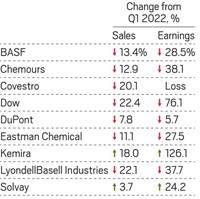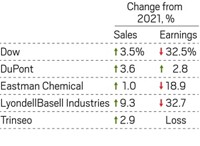Advertisement
Grab your lab coat. Let's get started
Welcome!
Welcome!
Create an account below to get 6 C&EN articles per month, receive newsletters and more - all free.
It seems this is your first time logging in online. Please enter the following information to continue.
As an ACS member you automatically get access to this site. All we need is few more details to create your reading experience.
Not you? Sign in with a different account.
Not you? Sign in with a different account.
ERROR 1
ERROR 1
ERROR 2
ERROR 2
ERROR 2
ERROR 2
ERROR 2
Password and Confirm password must match.
If you have an ACS member number, please enter it here so we can link this account to your membership. (optional)
ERROR 2
ACS values your privacy. By submitting your information, you are gaining access to C&EN and subscribing to our weekly newsletter. We use the information you provide to make your reading experience better, and we will never sell your data to third party members.
Economy
Covid-19
Chemical earnings crater in the second quarter
Companies selling into automotive and aerospace markets were hit the hardest
by Alexander H. Tullo
July 30, 2020
| A version of this story appeared in
Volume 98, Issue 30
With countries in North America and Europe mostly under lockdown, the second quarter bore the economic brunt of the COVID-19 pandemic. The US Bureau of Economic Analysis estimates that US gross domestic product shrank by a record 32.9%.
Source: C&EN tabulations based on company documents.
Note: Dow, Covestro, and Huntsman suffered losses of $217 million, $60 million, and $30 million, respectively.

For chemical companies, it was the worst quarter in decades, with nearly all firms posting double-digit drops in sales and earnings, and a handful posting losses. Most companies have been cutting costs, some opting for layoffs.
Exposure to some sectors was particularly painful. For example, in his remarks to analysts on July 29, BASF CEO Martin Brudermüller estimated that the global auto industry saw a 45% sales decline during the second quarter.
Aerospace might have been worse. “What we’ve seen in aerospace is just unprecedented,” Huntsman CEO Peter R. Huntsman told stock analysts. Hard-up airlines aren’t even taking delivery on airplanes that are already built, he said.
Support nonprofit science journalism
C&EN has made this story and all of its coverage of the coronavirus epidemic freely available during the outbreak to keep the public informed. To support us:
Donate Join Subscribe
Huntsman posted a $30 million loss for the quarter. It was driven by a sharp downturn in sales of advanced materials for aerospace, textile chemicals and polyurethanes for construction and auto markets.
Dow, another polyurethane chemical maker, also posted a loss. The firm announced on July 23 that it will shed 2,200 employees, about 6% of its workforce.
The German polyurethane producer Covestro reported a loss of about $60 million. Its polyurethanes segment experienced a 39% decline in sales. And its polycarbonate business saw a 28% drop in sales, despite gains in COVID-19-related businesses like materials for face shields.
Covestro executives said they have completed a previous goal of axing 400 jobs by year end. Further job reductions, numbering in the low hundreds, are still to come, they said.
DuPont reported profits of $514 million but also took a $2.5 billion charge related to its transportation materials business, which posted a 34% sales drop during the quarter. The firm saw growth in electronic materials and a 60% increase in protective garment sales in its Tyvek business.
At BASF, polyurethanes slumped, along with engineering polymers, auto coatings, and emissions catalysts. Sales of chemicals for consumer products and construction also fell. The drops were mitigated by strength in agricultural chemicals, nutritional ingredients, and cleaning chemicals. On balance, the firm, the world’s largest chemical maker, absorbed a 12.4% decline in sales and a 69.9% decline in profits.
BASF has accelerated a program—announced a year ago—to reduce its workforce by 6,000 positions, about 5% of its total. The company plans to complete the cuts by the end of this year, rather than in 2021 as originally planned.
Solvay eked out a profit despite wide exposure to the auto, aerospace, and oil and gas industries, which the pandemic has hit hard. The Belgian firm’s sales dropped by 18.0% during the quarter and profits dropped by 53.9%.
CEO Ilham Kadri says in a statement that Solvay employees did a good job “managing what is within our control exceptionally well.” For instance, the company cut about $200 million in costs so far this year.
A rare exception to the carnage was Ashland, where profits actually increased modestly. Performance was driven by the company’s consumer products business, which saw strong demand for drug excipients, biofunctional ingredients, and additives for sanitizers.
Chemical executives expect business to pick up in the third quarter as the pandemic eases. They are less certain about how strong the bounce will be or when the economy will return to 2019 levels. “While significant challenges clearly remain, based off July demand and the current order book, it appears global demand levels bottomed in the second quarter,” Celanese CEO Lori Ryerkerk told analysts.
Moody’s expects the outlook for the chemical industry to stabilize. “The improvement in many downstream industries should support better fundamental market conditions in the broader chemical industry for the rest of 2020,” the debt rating agency says in a report.
Correction
This story was updated on Aug. 5, 2020, because the table's footnote attributed incorrect values of losses to the companies. Dow, Covestro, and Huntsman suffered losses of $217 million, $60 million, and $30 million, respectively.




Join the conversation
Contact the reporter
Submit a Letter to the Editor for publication
Engage with us on Twitter